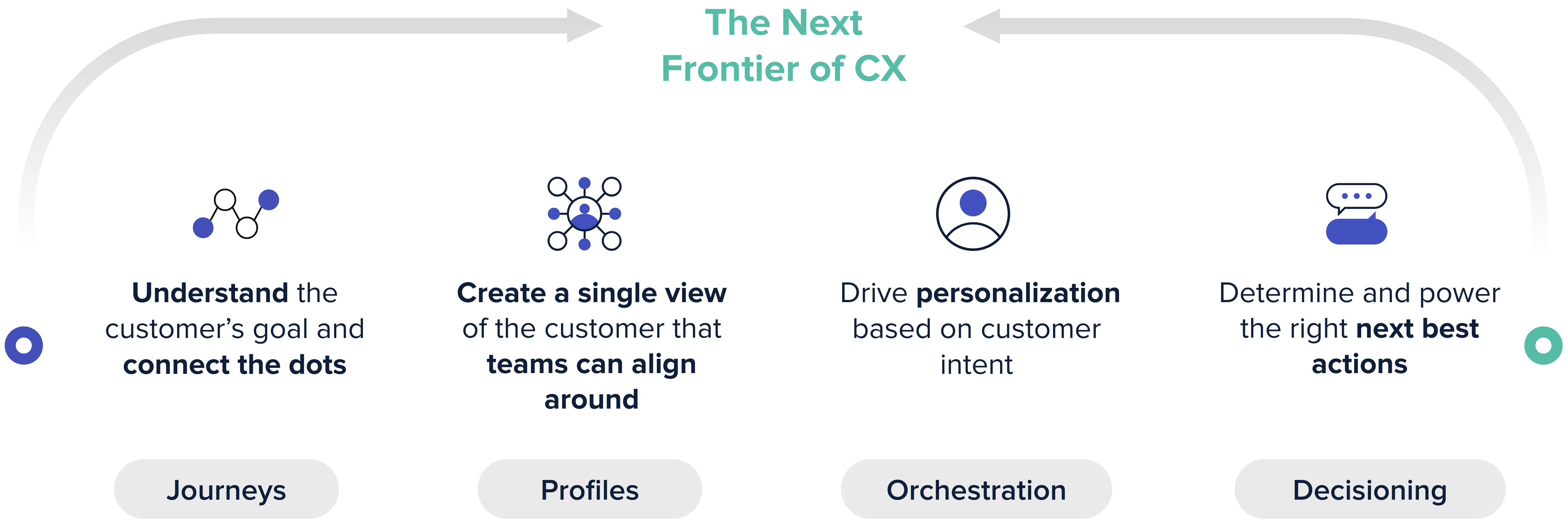Find out what personalized customer experiences are, why top brands are personalizing CX to lead their industries, and how your organization can deliver these engaging and unique experiences to every customer.
Personalization may seem like just another business buzzword, a passing trend that only concerns marketers. But the truth is this: customer experience (CX) professionals need to care about personalization, too. That’s because personalization is the future of customer experience and companies with top-performing CX programs are investing in personalizing every experience like never before.
First things first, though — what do we mean when we refer to personalization within the context of customer experience? Let’s dive in.
What is personalization, anyway?
In our customer experience glossary, we explain what we mean by personalized customer experience and define personalization as follows:
Personalization — When brands collect and use customer data and preferences to tailor interactions and outreach to the individual, such as addressing customers by first name, suggesting new products or services based on prior behavioral patterns, and thanking them for how long they’ve been doing business with the company.
You’ve likely seen this in action when you use one of your favorite subscription services — they ask you a few questions about your tastes, and then the company tailors the content and the user experience to match your preferences. Or, when you’re a member of a hotel loyalty program, and the brand remembers the type of property and room you like.
As a customer, you understand the value of being treated as an individual. Being offered a personalized customer experience feels different. It feels like the brand knows who you are, what you care about, and what you want or need.
Why Customer Experience Leaders Need to Personalize Experiences
While most companies recognize the impact of customer experience, it’s time to evolve beyond adopting strategies to improve the overall customer experience, as if customer experience is one-size-fits-all. Customer experience is anything but. What’s a great experience for me, may be a less-than-ideal interaction for you.
That’s why today’s and tomorrow’s customer experience leaders need to embrace personalizing the customer experience at the 1:1 level to remain relevant and drive customer satisfaction and retention.
Personalization is the future of customer experience
While traditionally, customer experience practitioners may have viewed measuring customer experience through the lens of KPIs like Net Promoter Score (NPS®) as one of their key priorities, that’s evolving. Today’s savvy customer experience professionals recognize they can do more than monitor and analyze — they can change the experience in real time, by learning about individuals in the moment and using these insights to improve the customer experience, not just for all customers, but at the individual level.
It’s something that’s not only simply nice to do — this is also a best practice that sets leading brands apart from the competition.
In fact, researchers at the Medallia Institute studied 580 organizations and their customer experience programs to identify what separates CX leaders from CX laggards, and they found that companies with top customer experience programs are 2x as likely to prioritize personalizing the customer experience across interactions.
Experiences — and good experiences — differ from customer to customer
Millennials might want a different type of experience than customers of different generations. In the United States, midwesterners may have different expectations than people in the northeast. Even within cohorts, individuals may have different expectations.
When you look at your customer experience data by segment, it’s easy to spot preferences and differences in behavior by cohort. But more than simply uncovering these insights, it’s possible — and crucial — to act on them to improve outcomes across segments.
To meet customers where they are, you need to prioritize personalizing the customer experience
Imagine Company A has established a business goal of creating the best contact center customer experience. Sounds like a great idea in principle, right? In reality, however, that’s not necessarily the most effective way to ensure the best customer experience at the individual level.
Imagine Company B has set a different priority, to personalize the customer experience across channels and interactions — that’s going to be a much more effective approach, especially when you consider there are most likely channels that can never be optimized at the individual level if they’re channels where customers don’t want to engage in the first place.
4 Steps to Personalize Customer Experience

Want to get started evolving your customer experience strategy from a generalized approach to personalized approach? Here are four steps to jumpstart your efforts.
#1. Adopt a customer journey mindset
A big key to personalization in the future will be about starting from a customer journey perspective rather than from a department or siloed perspective.
Instead of evaluating brand performance and customer outcomes channel by channel — analyzing the customer experience of an organization’s contact center or website — delivering personalized customer experiences requires adopting a more holistic approach to measuring how the brand is doing overall to meet and engage customers and help them along their customer journeys, whether they’re buying something or booking something.
#2 Create a single customer view that everyone within the organization is aligned to
Organizations need a single source of truth for each individual customer. These customer profiles can be created based on a data lake or a customer data platform (CDP) — what’s most important is that they enable everyone across the organization to immediately understand a customer’s entire history by collecting key information at every interaction and across channels. Having a single customer view in place can help organizations break down silos across the business.
For example, think about if a customer is having a poor website experience. What are they going to do next? They most likely will reach out to customer support via any number of channels, which will in turn impact the contact center. That’s why it’s important to have consistent information across teams to be able to break barriers and seamlessly solve problems for customers.
Customer profiles are building blocks that let brands start to personalize and orchestrate experiences.
#3. Orchestrate your customer journeys
You’re collecting customer insights, and you know what actions your customers are taking, how they feel, and what their experience is like.
Once you have this kind of data in place, the next step for acting upon it is customer journey orchestration, or driving personalized experiences based on what you know about an individual customer. This could be as simple as something you’re observing in the moment — they’re looking at a certain product on your company’s website — or knowing their specific customer segment, such as becoming a new parent.
Orchestration is a simple, rules-based approach to personalization that follows an “if this, then that” format. That is, if you see a customer doing X, your brand will do Y. For example, if you see your customer cancel an upcoming reservation, your customer service may reach out to see if there’s anything that can be done to get the customer to come back at another time.
#4. Evolve beyond journey orchestration; embrace decisioning to power the next best actions
While orchestrating customer journeys using an “if this, then that,” approach is an important step in offering personalized experiences, brands with more mature customer experience programs take things to the next level by using decisioning to power the next best actions.
Decisioning involves evaluating and predicting the next best actions brands should take when interacting with customers along their journey based on whatever is happening, moment to moment. That may be using insights to modify a contact center script or pausing marketing outreach to a given customer.
There are lots of different things a company could potentially decide to do to personalize the customer experience based on context, and those things might change depending on what we know about the customer.
Start Making Customers Feel Engaged by Personalizing Customer Experience
Customer experience is a fundamental pillar of an organization that’s key to business success. The next horizon of excellence will challenge organizations to deliver personalized experiences at the individual level throughout the customer journey.
Companies that get this right will become smarter and more agile, resulting in higher customer loyalty, increased sales, and reduced costs.








